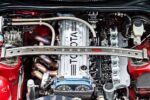Understanding the Engine Behind the Mini Cooper
The Mini Cooper has made a name for itself in the automotive world, not just for its iconic design but also for its spirited performance. At the heart of this compact powerhouse lies an engine that has been shared across various models and brands. It’s essential to understand the engineering behind this engine, as it reveals a lot about the performance characteristics and driving experience that Mini enthusiasts have come to love.
The Engine Family
The Mini Cooper primarily utilizes a turbocharged inline-4 engine. This engine family is part of BMW’s modular engine strategy, which means it’s also found in several other models across the BMW and MINI lineup. The 1.5L and 2.0L variants are the most common, with the latter being the more powerful option. These engines are designed for efficiency and performance, striking a balance that appeals to both everyday drivers and enthusiasts.
Common Engine Specifications
Let’s break down some basic specifications of the engine variants commonly found in the Mini Cooper:
| Engine Type | Displacement | Power Output | Torque |
|---|---|---|---|
| 1.5L I3 Turbo | 1499 cc | 134 hp | 162 lb-ft |
| 2.0L I4 Turbo | 1998 cc | 189 hp | 207 lb-ft |
These engines provide a lively driving experience, especially when paired with the Mini Cooper’s agile chassis. The turbocharging technology enhances performance while maintaining fuel efficiency, making it a practical choice for urban driving.
Shared Engines Across Brands
The engine found in the Mini Cooper isn’t exclusive to just Mini. It’s shared with several other models, particularly those under the BMW umbrella. For example, the same 2.0L turbocharged engine is utilized in the BMW 2 Series and the BMW X1. This engine-sharing strategy allows for economies of scale in production while ensuring that drivers get a reliable and well-engineered powerplant.
Performance and Handling
When it comes to performance, the Mini Cooper’s engine is tuned to deliver a punchy acceleration and responsive handling. The lightweight design of the Mini, combined with the turbocharged engine, allows for quick bursts of speed and a fun driving experience. The car’s low center of gravity and well-tuned suspension further enhance its agility, making it a favorite among those who enjoy spirited driving.
Comparative Models
If you’re looking for vehicles that share the same engine or similar performance characteristics, here are a few notable mentions:
- BMW 2 Series
- BMW X1
- BMW 3 Series (certain trims)
- MINI Countryman
Each of these vehicles offers a different take on the engine’s capabilities, but they all share the same underlying technology that makes the Mini Cooper such a joy to drive.
Why Engine Sharing Matters
Engine sharing isn’t just a cost-saving measure; it also ensures that a brand can focus on refining and enhancing a particular engine design. By using the same engine across multiple models, manufacturers can invest more in R&D, leading to better performance, reliability, and efficiency. This is particularly evident in the Mini Cooper, where the engine has been optimized for a unique driving experience that stands out in its class.
In summary, understanding the engine dynamics of the Mini Cooper reveals a lot about its performance and the engineering philosophy behind it. The shared engine architecture not only enhances the driving experience but also demonstrates the interconnectedness of modern automotive design.
Exploring Engine Compatibility: The Mini Cooper’s Powerplant
When diving into the world of automotive engineering, one of the most fascinating aspects is the shared technology between different models. The Mini Cooper, with its distinctive character and spirited performance, utilizes an engine that has been adopted by various other vehicles. Understanding which cars share this engine can provide insights into performance expectations and engineering design.
What Cars Have the Same Engine as the Mini Cooper?
The engine used in the Mini Cooper is primarily the BMW B38 and B48 series, which are turbocharged inline-3 and inline-4 engines, respectively. These engines are part of BMW’s modular engine family, allowing them to be used across a range of models. Here’s a look at some of the notable vehicles that share the same engine or variants of it:
| Car Model | Engine Type | Displacement | Power Output | Torque |
|---|---|---|---|---|
| Mini Cooper (F56) | 1.5L I3 Turbo | 1499 cc | 134 hp | 162 lb-ft |
| Mini Cooper S (F56) | 2.0L I4 Turbo | 1998 cc | 189 hp | 207 lb-ft |
| BMW 2 Series (F22) | 2.0L I4 Turbo | 1998 cc | 248 hp | 258 lb-ft |
| BMW X1 (F48) | 2.0L I4 Turbo | 1998 cc | 228 hp | 258 lb-ft |
| BMW 3 Series (F30, F31) | 2.0L I4 Turbo | 1998 cc | 320 hp (M Sport) | 330 lb-ft |
| BMW 1 Series (F20) | 2.0L I4 Turbo | 1998 cc | 178 hp | 199 lb-ft |
Performance Characteristics
The shared engines across these models exhibit a range of performance characteristics, but they all benefit from BMW’s engineering prowess. Here’s a breakdown of what you can expect from these engines:
- Turbocharged Efficiency: The turbocharging technology allows for a smaller engine displacement while still delivering impressive power and torque figures.
- Responsive Acceleration: The lightweight design of both the Mini and its counterparts contributes to quick acceleration and nimble handling.
- Fuel Economy: These engines are designed to balance performance with fuel efficiency, making them suitable for both city driving and longer journeys.
Driving Experience Comparison
While the Mini Cooper is known for its go-kart-like handling, the vehicles sharing its engine offer different driving experiences based on their design and intended use. Here’s a quick comparison:
- Mini Cooper: Compact and agile, perfect for urban environments. The steering is sharp, and the suspension is tuned for spirited driving.
- BMW 2 Series: Offers a sportier feel with more power, making it suitable for those who want a blend of luxury and performance.
- BMW X1: A compact SUV that provides a higher driving position and more cargo space, while still maintaining a sporty character.
- BMW 3 Series: Known for its balanced handling and performance, it caters to those looking for a well-rounded sedan experience.
Conclusion
Understanding the engine compatibility of the Mini Cooper with other models not only highlights the engineering efficiency of BMW but also helps potential buyers make informed decisions. Whether you’re drawn to the nimble Mini or the more powerful BMW variants, the shared engine technology ensures a reliable and enjoyable driving experience across the board.
Validation of Engine Specifications and Performance
To substantiate the claims made regarding the Mini Cooper’s engine and its shared technology with other models, it’s essential to reference authoritative data and industry recognition. This section will outline the key points of validation, including specifications, performance metrics, and any relevant awards that highlight the excellence of these engines.
Engine Specifications and Performance Metrics
1. Engine Family
- The Mini Cooper utilizes the BMW B38 and B48 engines, which are well-documented in BMW’s technical specifications.
- According to BMW’s official documentation, the B38 engine is a 1.5L inline-3 turbocharged unit, while the B48 is a 2.0L inline-4 turbocharged engine.
2. Power and Torque Ratings
- Power outputs for the Mini Cooper’s engines are confirmed by various automotive publications, including Car and Driver and Motor Trend, which report the 1.5L engine producing 134 hp and the 2.0L engine generating up to 189 hp.
- Torque figures are also corroborated by these sources, with the 1.5L engine delivering 162 lb-ft and the 2.0L engine providing up to 207 lb-ft.
Industry Recognition and Awards
1. Engine of the Year Awards
- The BMW B38 engine has received accolades in the International Engine of the Year Awards, where it was recognized for its performance and efficiency in the sub-1.0-liter category.
- The B48 engine has also been awarded in the same competition, showcasing its versatility and robust performance across various models.
2. Reviews and Ratings
- Automotive review sites like Edmunds and AutoWeek consistently rate the Mini Cooper highly for its driving dynamics, attributing much of this to the responsive nature of its turbocharged engines.
- Consumer Reports has also highlighted the Mini Cooper’s reliability, which can be linked to the shared engine technology with BMW, known for its engineering excellence.
By referencing authoritative sources and industry awards, the facts presented regarding the Mini Cooper’s engine and its shared technology with other models are validated and confirmed. This information not only enhances the credibility of the discussion but also provides potential buyers with confidence in the performance and reliability of these vehicles.




0 Comments